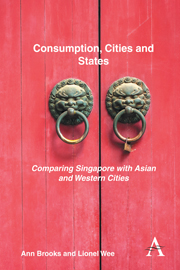Book contents
- Frontmatter
- Contents
- Acknowledgments
- Introduction
- Chapter 1 Consumption, Reflexivity and Citizenship in Global Cities
- Chapter 2 Orders of Reflexivity
- Chapter 3 Rescaling for Competitiveness
- Chapter 4 The Dynamics of State–Society Negotiations
- Chapter 5 (De-)Regulating Asian Identities: Comparing Asian Cities and States
- Chapter 6 Citizenship, Reflexivity and the State: Investigating ‘Defensive Engagement’ in a City-State
- Chapter 7 Governing the Citizen-Consumer: Citizenship, Casinos and ‘Cathedrals of Consumption’
- Chapter 8 Regulating Consumption and the ‘Pink Dollar’
- Chapter 9 States as ‘Midwives’ to Cities: Cosmopolitanism, Citizenship and Consumption in the Modern State
- References
- Index
Chapter 7 - Governing the Citizen-Consumer: Citizenship, Casinos and ‘Cathedrals of Consumption’
Published online by Cambridge University Press: 05 September 2014
- Frontmatter
- Contents
- Acknowledgments
- Introduction
- Chapter 1 Consumption, Reflexivity and Citizenship in Global Cities
- Chapter 2 Orders of Reflexivity
- Chapter 3 Rescaling for Competitiveness
- Chapter 4 The Dynamics of State–Society Negotiations
- Chapter 5 (De-)Regulating Asian Identities: Comparing Asian Cities and States
- Chapter 6 Citizenship, Reflexivity and the State: Investigating ‘Defensive Engagement’ in a City-State
- Chapter 7 Governing the Citizen-Consumer: Citizenship, Casinos and ‘Cathedrals of Consumption’
- Chapter 8 Regulating Consumption and the ‘Pink Dollar’
- Chapter 9 States as ‘Midwives’ to Cities: Cosmopolitanism, Citizenship and Consumption in the Modern State
- References
- Index
Summary
Introduction
Citizenship and its links to the rights of individuals have become increasingly complex. The impact of globalization has fundamentally transformed the conceptualization of citizenship, the rights and responsibilities accruing to individuals, and the obligations of states that oversee increasingly diverse populations. The movement of peoples through migration and settlement has changed previously clearly defined homogenous populations into increasingly heterogeneous groupings made up of individuals with different racial and cultural backgrounds and forming different categories of citizenship (Glenn 2002, 2011; Nash 2010; Turner 2011). Citizenship is in fact being increasingly defined by ‘gradations of esteem’ (Carver and Mottier 1998), which recognize that different kinds of rights and responsibilities accrue to different categories and subcategories of citizens based on considerations of ‘relative productivity’. What has been left out of these discussions is any attention to the citizen as consumer. The interface between citizen status and consumer activity is important because of the neoliberal assertion that individuals and institutions perform at their best within a free-market economy and because of the state's expectations regarding citizens’ rights and responsibilities as consumers, not just as producers. Our goal in this chapter is to analyze the context of a more dynamic definition of citizenship as a result of globalization and examine these relationships within the context of a particular case study. This involves an exploration of how the state in Singapore aims to regulate the patronage of casinos, which have been recently introduced into Singapore.
- Type
- Chapter
- Information
- Consumption, Cities and StatesComparing Singapore with Asian and Western Cities, pp. 107 - 130Publisher: Anthem PressPrint publication year: 2014



